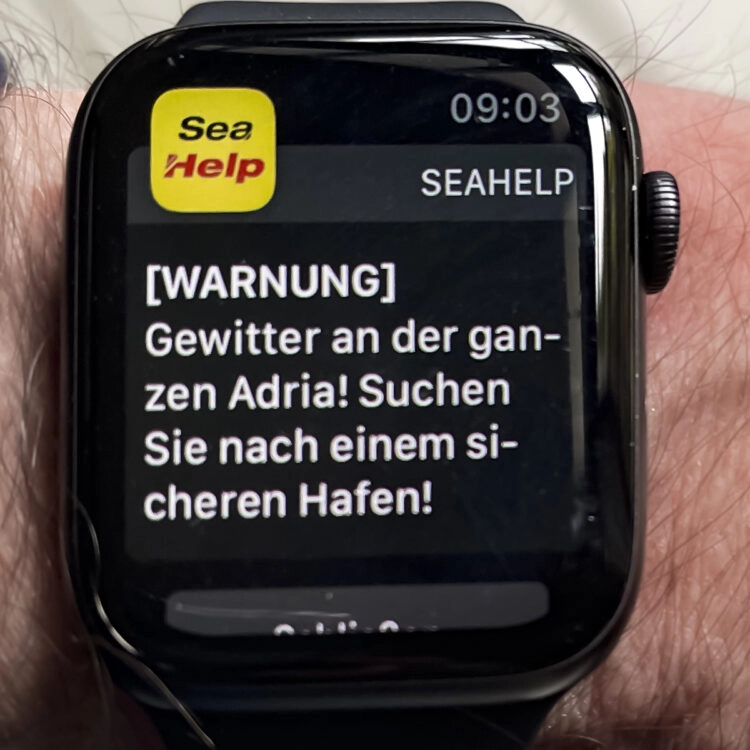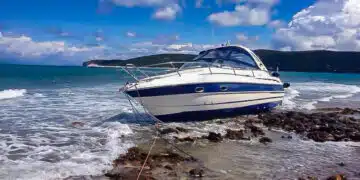On August 1 and 2, several tornadoes of category F1 swept over Istria, especially the southern tip of the northern Croatian vacation region with Cape Kamenjak / Istria and the region around the port city of Pula / Istria were affected. However, there was no major damage, although in the sky and on the water there was an unusual natural spectacle, which of course also represents a significant potential danger for all skippers in the region of Istria.
A skipper of the charter company Vito Nautika in Pomer was at the time just on the move with a crew and sent the editorial staff impressive photos and videos of the F1 tornado over Istria. In particular, the metallic sound of the tornado or the whirlwind probably evokes a certain “goosebumps” feeling in every skipper, when you imagine yourself becoming the plaything of the forces of nature.

Mit dem Laden des Videos akzeptieren Sie die Datenschutzerklärung von YouTube.
Mehr erfahren
Impressive footage of a tornado, which succeeded an employee of the charter company Vito Nautika in Pomer / Istria. Please be sure to turn on sound, the slightly metallic sound of the tornado is already very special.
When there is a danger of tornado: nothing like away…!
But the most important thing: How should you behave as a skipper if such a tornado or a tornado suddenly appears? Given the impressive soundscape of the accompanying winds even at a greater distance and the visual appearance, the instinct to flee inherent in most people is actually enough: One should put as much distance as possible between oneself and the tornado or twister as quickly as possible, because depending on the prevailing winds, rapid changes in direction of the tornado or twister cannot be ruled out.
For sailors, this means: if necessary, take in the sails and move away under engine power in the opposite direction of the tornado. Motorboats or motor yachts should also move away from the area of influence of the tornado as quickly as possible. As a precaution, it is recommended that everything on deck be moored securely and that people who are not needed there be sent below deck in any case. Life jackets should also be put on or remain on there as a precaution.
But what exactly is a tornado or a tornado? It is simply a vortex of air that reaches from a cloud to the earth and is visible from afar due to the trunk that reaches from a cloud to the ground or the surface of the water. The term tornado comes from the Latin word “tornare,” which means “to turn” or “to reverse.” The equally common form, namely the so-called “Windhose” has nothing to do with the German word “Hose”, “hose” comes from the English language and translated means as much as “hose”. The terms “tornado” and “whirlwind” describe one and the same phenomenon, even if recent reporting has given the impression that tornadoes have a much higher destructive power than the whirlwinds.
F1 tornado with winds up to 180 km/h
Tornadoes are classified according to the so-called Fujita scale into classes between F0 and F 12, with the majority of tornadoes occurring in the Mediterranean, especially in Croatia, being classified as F 1. Here, wind speeds of about 118 to 180 km/h prevail inside the tornado’s trunk, which can already cause considerable damage, especially on motor or sailing yachts, but also on land. Tornadoes can be active up to a maximum of one hour, but on average they rage only about ten minutes and change their location at a speed of about 50 km / h, waterspouts often remain in place.
Evolution of a tornado
How exactly a tornado or a waterspout is formed is explained by meteorologist Karsten Schwanke in an extremely interesting video that we do not want to withhold from our readers here.
Free SeaHelp app warns of dangers
Even though it is not yet possible to reliably predict the formation of tornadoes, their constant companions include thunderclouds, which (explained simply) always form when warm and cold air masses collide. And this is precisely where the SeaHelp app for cell phones comes in: anyone who downloads it receives corresponding SeaHelp weather warnings and can prepare themselves for the possibility of imminent danger. It does not always have to be a tornado or a tornado. In the Apple App Store there is a free download option of the SeaHelp app for iOS phones as well as in the Google Play store for Android phones.














